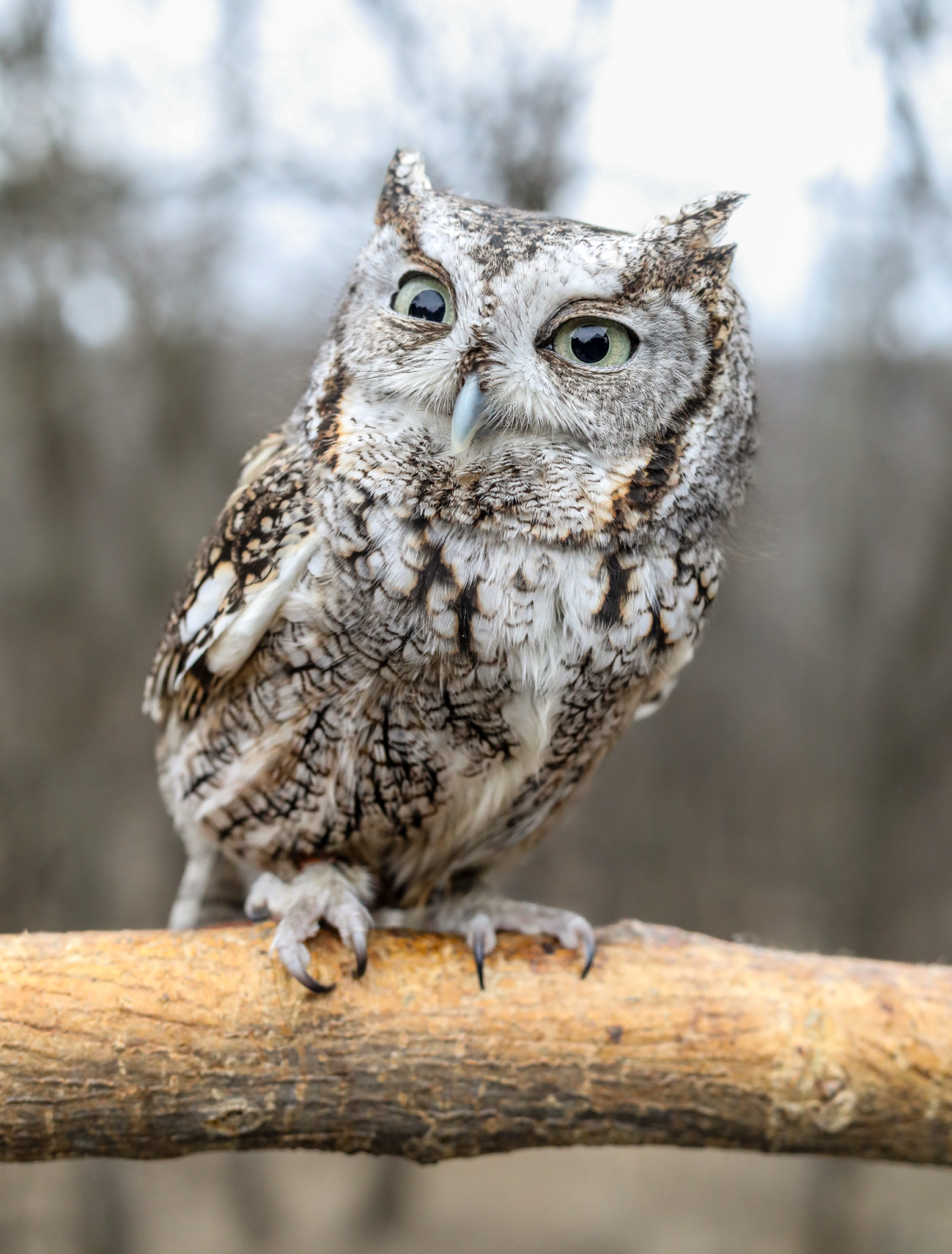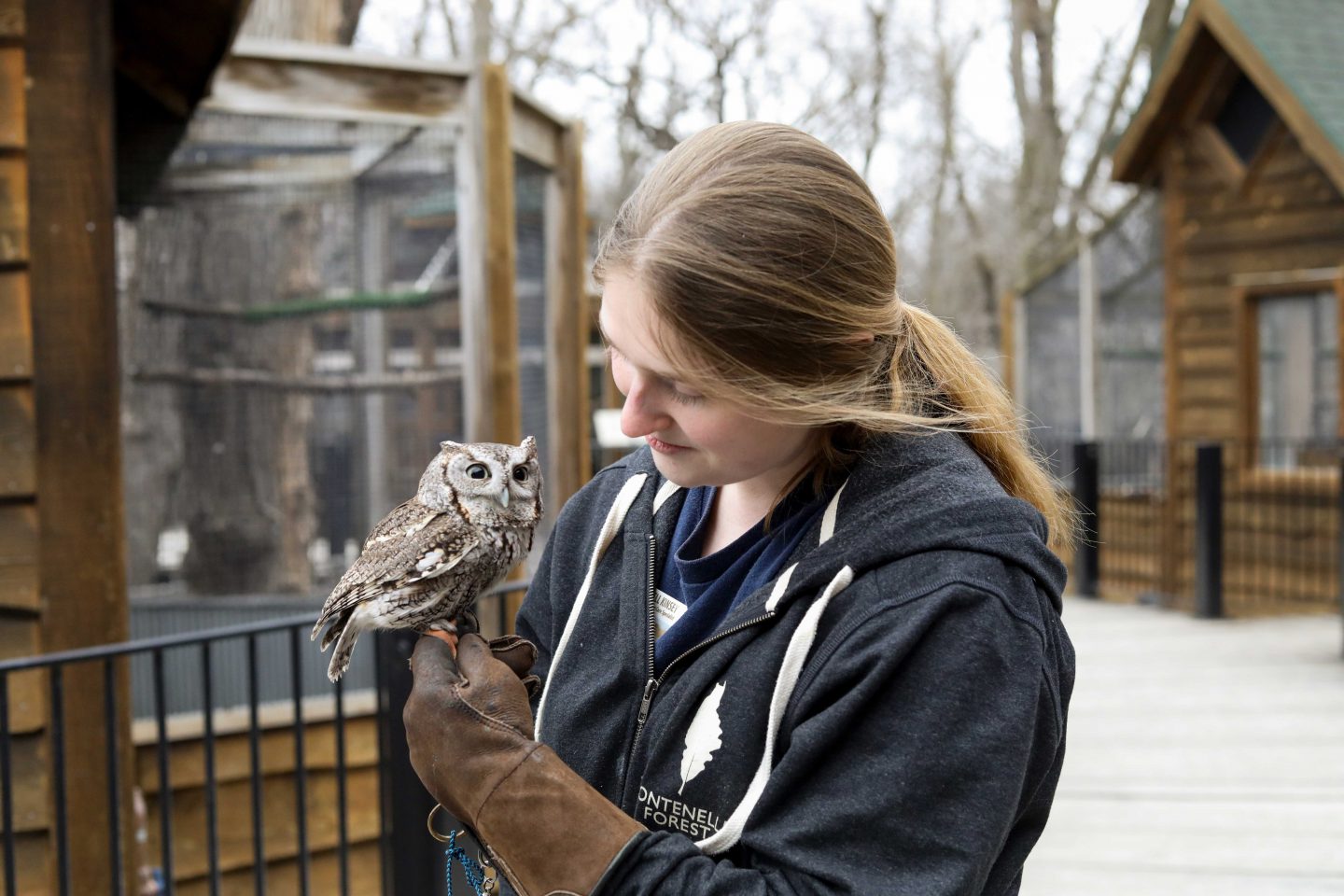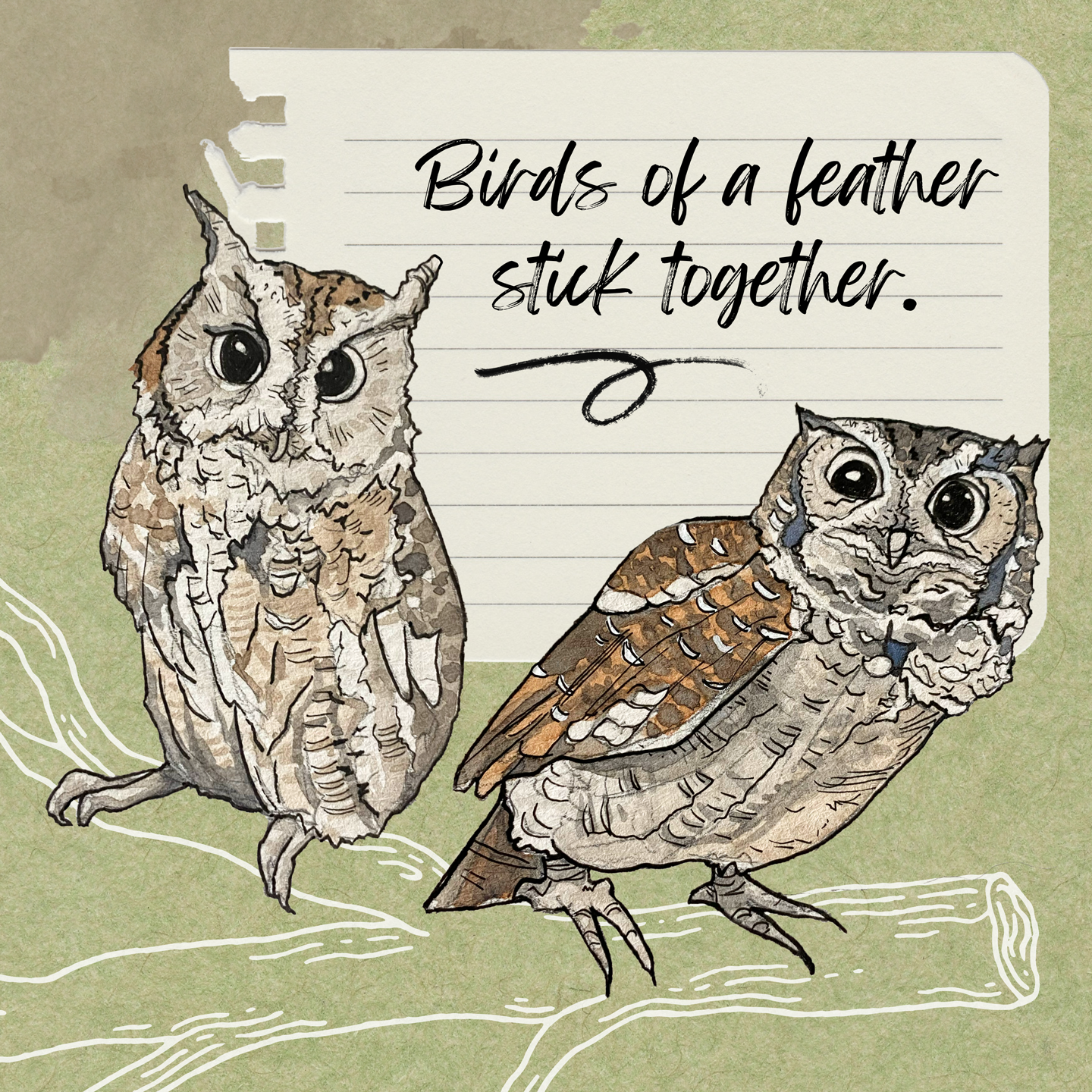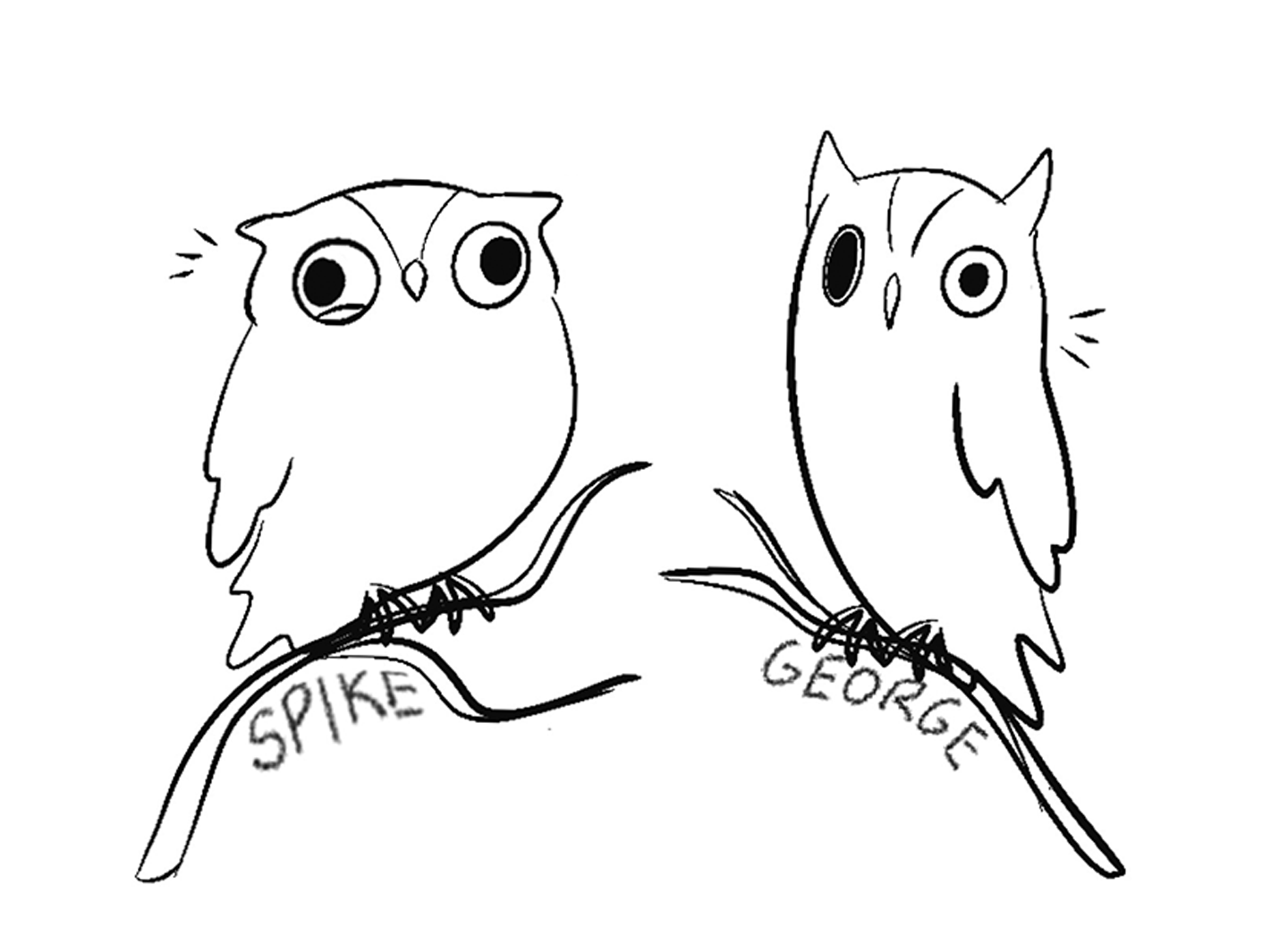
By Renae Blum
Something squeezes the heart when you look at Spike, a 5-inch-tall eastern screech owl living with a raptor conservation organization in Bellevue. One of his eyes perpetually squints, giving him a bewildered expression. And both eyes — huge, bottomless, round, seemingly seeing everything and nothing at once — appear slightly off-kilter, not perfectly in sync.
In one video, now viewed more than 9 million times on Instagram alone, Spike’s handler and one of his main caregivers, Ell Kinsey, gently waves a hand close to the bird’s face, as if checking for signs of life.
Spike doesn’t appear to react, and she explains, “He’s just not all there. He doesn’t have that typical wild awareness that a normal screech owl should have.”
Despite that, the 3- or 4-year-old owl is alert, calm and seemingly content in his second chance at life — millions of online admirers in tow.
A Chance Encounter
In September 2023, a railroad employee rescued Spike from inside a sweltering train car in Fremont. No one knows how long he’d been trapped inside, but by the time he was rescued, Spike was starving, and the heat had permanently damaged his brain.
Staff at the Raptor Conservation Alliance near Elmwood got him back to a better weight, but realized he could not be released back into the wild. He could still fly, but his ability to hunt, and his natural fear of predators, was gone.
Kinsey believes that before this, Spike — who she named for a railroad spike — was indeed a mighty hunter. Generally, only one in four screech owls survive their first year, and many don’t make it through their first winter.
But Spike was at least a year old when he was found.
“The fact that he made it to adulthood says a lot about the kind of hunter he was before the train car,” Kinsey said. “Every now and then, we get a glimpse of that hunter.”

New Beginnings
When the Raptor Conservation Alliance deems a bird non-releasable, the next stop may be Fontenelle Forest. One of Nebraska’s oldest conservation organizations, Fontenelle is home to 27 non-releasable raptors. They receive specialized care, customized enclosures and the opportunity to live new lives as educational ambassadors.
Some live in the Raptor Woodland Refuge, a large exhibit open to public view. Others, like Spike, aren’t on public display, because they’ve shown the aptitude to educate people in other ways.
These birds travel with Kinsey and other staff to local communities, appearing in programs at schools, senior care facilities and day camps.
“[Spike] went on his first program probably about a month after we got him,” Kinsey said. “He was a real, real good bird — easy to train.”
During the summer, Spike may appear at up to three events a week, though his schedule is quite flexible. Staff keep a careful eye on each bird and rotate between them, sometimes swapping one bird for another on a given day, to ensure none of them are stressed or exhausted.
“Spike and George back each other up,” Kinsey said, referring to Spike’s roommate, a 12-year-old eastern screech owl with an eye injury. George had rejected multiple previous roommates, either refusing to eat or picking fights.
But on their first night in the same enclosure, staff were amazed to see the older bird bring Spike his leftover mouse from the night before — something only a mate or parent typically does. Kinsey can’t be sure, but she believes George sensed Spike’s limitations.
“He seemed to know, OK, this guy needs a little bit of extra help,” Kinsey said.

Life at Fontenelle
Dozens of people aided in Spike’s recovery and are now part of his everyday life. But Kinsey is “the mouse bringer,” as she calls herself.
Despite that prestigious title, and despite working with Spike and George for years, she doesn’t believe they recognize her visually.
“But I know when they hear my voice, that usually means ‘mouse’ or ‘glove’ or something to that effect,” she said.
At the end of the day, staff lock the gates, and then the raptors get their evening meal. Spike eats one mouse each day. “It’s 20 grams, so I always compare that to, like, 20 paperclips,” Kinsey said.
Kinsey is hesitant to assign a wild animal more human qualities, or to speculate about what his personality might be. In Spike’s case, mentally, “I don’t think there’s a lot going on,” she said. But she and the staff do recognize signs of stress versus contentment, which they monitor for.
If Spike does have a personality, “derpy” is the best word for it, according to Kinsey. “He’s the hardest one to resist petting,” she said.

A Star is Born
Spike’s first video appearance came from an idea of Kinsey’s: “I saw that stupid trend online of showing someone something they had never seen before. I was like, oh my gosh, we have to do that with one of our birds!”
She encouraged the team to pick Spike for the video, and he was a natural — gazing at a water fountain, break room freezer, wall certificate and more, all with the same wide-eyed, seemingly amazed expression.
“We thought that was viral. It got, like, 100,000 views,” she recalled.
But Spike’s true breakthrough moment came later, when Kinsey appeared alongside him in a video “introducing” him to their audience.
Kinsey still remembers the moment she realized how big the video had gotten. She was hiking and had stopped to sip water and check Instagram. A rising Brooklyn-born singer-songwriter, INIKO, had commented and clicked the “heart” button on the post.
“I remember freaking out at that,” Kinsey said. “I texted our social media manager … and it just blew up from there.”
Fans began sending staff their Spike and George fan art. Donations came in from places like Canada, Germany, Italy and Australia. And in one year, Fontenelle Forest’s Instagram following increased by more than 700 percent.
“It’s amazing, the influence and reach that he has,” Kinsey said.
Seizing the moment, Fontenelle staff created a Spike and George T-shirt to sell in the gift shop, and in June, a sold-out crowd attended an in-person meet-and-greet with Spike and George. Virtual and in-person private meetings are also in the works.

With a Little Help from My Friends
Why has Spike become so beloved? Peek through the comment sections and you’ll see mostly good-spirited humor — “I would die for Spike” or “Spike is my spirit animal” — but also sincere emotion.
One person wrote, “I’m having such a rough day, and seeing Spike, and how he doesn’t let his limitations hold him back, really inspires me. … Seeing Spike made me smile.”
Kinsey fondly remembers one visitor who flew in from Chicago after requesting a private meeting.
“She was having some medical issues, and she said that Spike was a big part of her healing journey,” Kinsey said. “I think she appreciated the quality of life that we’re able to give the birds here.
“And that’s something that’s really important to me. The broken birds are not going to get tossed aside,” she said. “We don’t just discard something that doesn’t work right. I think that meant a lot.”
To see more of Spike’s adventures, follow Fontenelle Forest on Facebook, Instagram, X, YouTube or LinkedIn. Learn more at fontenelleforest.org.
